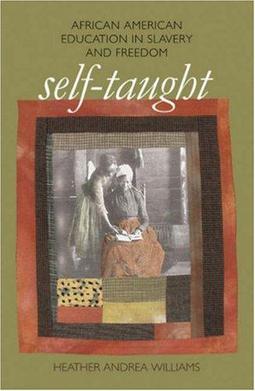Self-Taught facts for kids
 |
|
| Author | Heather Andrea Williams |
|---|---|
| Published | February 2007 (University of North Carolina Press) |
| Pages | 320 pp. |
| ISBN | 978-0-8078-5821-9 |
The book Self-Taught: African American Education in Slavery and Freedom shares the amazing history of how African Americans taught themselves to read and write. This story covers the time of slavery all the way through the Reconstruction Era, which was the period right after the American Civil War. The book was written by history professor Heather Andrea Williams and was published in 2007 by the University of North Carolina Press. It shows how important education was for freedom and a better future.
Contents
Why Learning Was So Important
During slavery, most enslaved African Americans were not allowed to learn to read or write. In fact, in many places, it was against the law to teach them. Slave owners often feared that educated enslaved people might try to escape or rebel. They also wanted to keep enslaved people from knowing about the world outside their plantations.
The Power of Knowledge
Even with these strict rules, many African Americans deeply wanted to learn. They knew that reading and writing were powerful tools. Education could help them understand their situation better. It could also help them communicate with others and even find ways to gain their freedom. Learning was a symbol of hope and resistance against the harsh system of slavery.
Secret Schools and Hidden Lessons
Because formal schools were forbidden, enslaved people often found creative and brave ways to learn. Some learned in secret, late at night, after long days of work. They might use whatever materials they could find, like scraps of paper or even dirt to practice letters. Sometimes, a child of the slave owner might secretly teach an enslaved child. Other times, free African Americans or sympathetic white people would risk their own safety to share knowledge. These secret lessons were dangerous but showed incredible courage and determination.
Education After Slavery
After the American Civil War ended in 1865, slavery was abolished. This period, known as the Reconstruction Era, brought new opportunities for African Americans. For the first time, they were legally free to pursue education. There was a huge desire to learn among newly freed people of all ages.
Building New Schools
During Reconstruction, many new schools were built for African American children and adults. These schools were often started by African American communities themselves. They were also supported by Northern missionaries and organizations like the Freedmen's Bureau. People who had been enslaved, from young children to elderly grandparents, eagerly attended these new schools. They understood that education was key to building new lives and becoming full citizens.
The Impact of Self-Education
The self-education that happened during slavery laid the groundwork for the educational boom during Reconstruction. The skills and determination gained in secret helped many become teachers and leaders in their communities. They used their knowledge to help others, set up churches, and even participate in politics. The book Self-Taught highlights how this strong desire for learning, even in the toughest times, shaped the future for African Americans and for the United States. It's a story about resilience, hope, and the lasting power of education.

